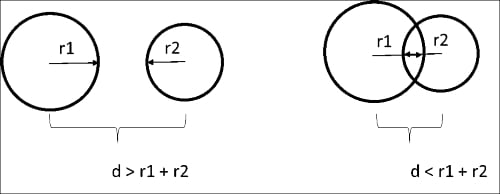One way to detect collision is to see how far each of the objects are from each other's center. This is known as circular collision detection because it treats each object as if it is bound by a circle, and uses the radius of that circle to determine whether the objects are close enough to collide.
Take a look at the following diagram:

The circles on the left are not colliding, while the circles on the right are colliding. For the non-colliding circles, the distance (d) between the center points of the two circles is greater than the sum of the two radii (r1 + r2). For the colliding circles, the distance (d) between the two centers is less than the sum of the two radii (r1 + r2). We can use this knowledge to test any two objects for collision based on the radii of the circles and the distance between the objects center point.
So, how do we use this information?
We will know r1 and r2 because we set them when we create the sprite.
We will calculate two legs of a right...



